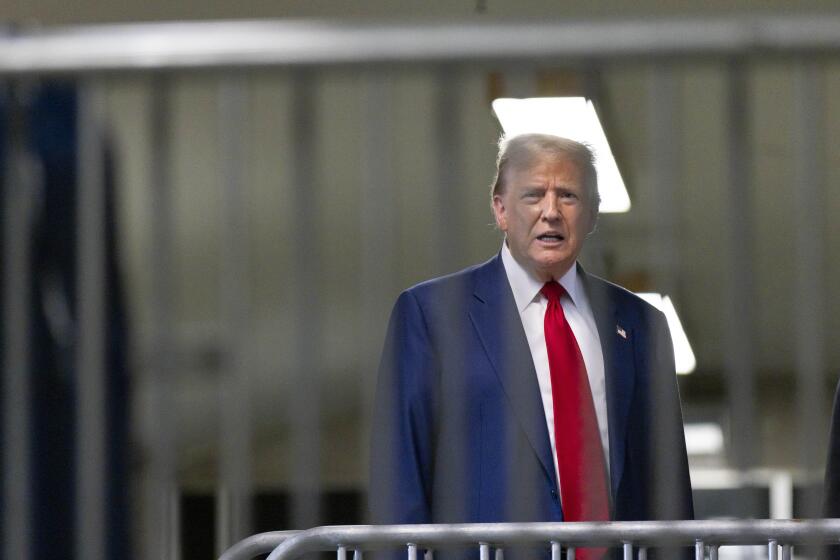As shutdown drags on, a simple equation shows why Trump is losing: 46% is less than 53%
Government shutdowns test political power, and right now, House Speaker Nancy Pelosi has more than President Trump.
There’s a simple reason for that: 53% beats 46%.
Pelosi’s Democrats won well over half the vote in the midterm election, Trump has never commanded more than the minority he won in 2016.
For the past two years, Republican control of both houses of Congress has shielded Trump from the full consequences of his thin support. With Thursday’s convening of the new Congress and Pelosi’s reelection as speaker, that’s changed.
Sign up for the Essential Politics newsletter »
ANOTHER BRICK IN THE WALL
Trump, who has taken few opportunities to rally public opinion to his side in the fight over the partial government shutdown, made an attempt Thursday afternoon, shortly after Pelosi’s reelection, but it underscored the weakness of his position.
The president made a brief appearance in the White House briefing room to advocate for his much-promised border wall, as Noah Bierman reported.
“Call it what you will, but without a wall you cannot have border security,” Trump said. He insisted that he’s “never had so much support as I have in the last week over my stance on border security ... and for, frankly, the wall, or the barrier.”
That may be true if one measures support the way Trump often does — by looking only at opinion among his existing backers. There’s no question that Trump voters support a wall, and Trump is almost obsessively focused on the concerns of his base.
But the 46% who voted for Trump in 2016 don’t constitute a majority, still less do the somewhat smaller number who firmly back him. Among the public at large, a significant majority oppose building a border wall, and even fewer support having taxpayers pay for a project that Trump as a candidate repeatedly — if unrealistically — said Mexico would pay for.
That gives Democrats, who have already agreed to at least $1.3 billion more for border security, a strong position in negotiations.
“We’re not doing a wall,” Pelosi said Thursday. “Does anyone have any doubt that we’re not doing a wall?”
Among those who ardently support Trump are the leaders of the union that represents Border Patrol agents. Trump brought them along with him to the briefing room, where they gave the desired pitch.
“We are all affected by the shutdown,” said Art Del Cueto, vice president of the union. “We have skin in the game. However, it comes down to border security.”
Del Cueto and his colleagues doesn’t actually have a lot of skin in the game yet. But they soon will.
Most federal workers, including Border Patrol agents, got paid at the end of December for work done before the shutdown started. Although the Border Patrol and some 400,000 other federal employees, including air traffic controllers, Secret Service agents and federal prison guards, are working without guarantee of being paid, so far, most haven’t actually missed a full paycheck.
Because of that, the Border Patrol union leadership can advocate for Trump’s policy positions without risking too much ire of members — for now.
The next federal payday for most workers comes late next week. If the shutdown hasn’t been resolved by then, the pinch will truly begin to be felt.
Already, some Republican senators facing tough reelections in 2020, including Cory Gardner of Colorado and Susan Collins of Maine, have called publicly for ending the shutdown without giving Trump the money he wants for the wall.
“I see no reason why the bills that are ready to go, and on which we’ve achieved an agreement, should be held hostage to this debate over border security,” Collins said Thursday.
As tens of thousands of constituents start having trouble paying their rent or making their mortgage payments in coming weeks, more Republicans inevitably will join that chorus.
The pressure from federal workers missing paychecks played a key role in ending the previous longest government shutdown at 21 days during the Clinton administration. This one seems likely to end the same way.
So far, although the parties have met, they’ve only shadow-boxed. At some point, actual negotiations will resume. When they do, unless something dramatically changes the dynamics, they’ll be meeting to set the terms for Trump’s surrender.
SPEAK SOFTLY AND CARRY A BIG GAVEL
Pelosi’s return to the speaker’s chair marked a historic comeback. Not since Sam Rayburn in 1954 has a person lost the gavel then regained it, as Jennifer Haberkorn and Sarah Wire reported. Along the way, the San Francisco Democrat faced down an insurgency that at one point seemed to threaten her plans, but in the end fizzled.
Beyond ending the shutdown, Democrats have set an agenda that’s not likely to produce much legislation for the president to sign, given Republican control of the Senate, but which could frame the debate for the 2020 election.
The lead items include multiple investigations of the administration, hearings on the impact of climate change and bills to, among other things, toughen government ethics standards and require presidents to release their tax returns.
Democrats also plan to keep a spotlight on healthcare, the issue that more than any dominated their successful campaigns in the midterm elections.
As Haberkorn wrote, the healthcare issue has turned into a major liability for Republicans, worsened by a decision last month by a conservative federal district judge in Texas who ruled that the Affordable Care Act was unconstitutional.
District Judge Reed O’Connor on Sunday put his ruling on hold pending appeal, and many legal experts expect he’ll ultimately be reversed.
For now, however, his ruling has given substance to Democratic warnings that Republicans want to eliminate popular sections of the healthcare law, including its protections for people with preexisting conditions. That poses a major challenge for GOP lawmakers, whose party activists continue to oppose the law, even as most Americans favor it.
MEASURE MY TENURE BY WHAT I PREVENTED
Former White House Chief of Staff John F. Kelly gave a lengthy interview to Molly O’Toole which had a singular theme: His tenure should be judged by the bad decisions he stopped.
From pulling U.S. forces out of South Korea to withdrawing from NATO, Kelly’s supporters say he confronted, and blocked, a long list of Trump ideas.
All that, of course, inevitably raises the question of what Trump will do now, with Kelly and former Defense Secretary James N. Mattis out of his way.
Trump hasn’t responded to Kelly’s criticism, but he sharply attacked Mattis on Wednesday during a rambling, 90-minute soliloquy to the press pool in which he also endorsed the 1979 Soviet invasion of Afghanistan, as Eli Stokols reported.
ROMNEY REDUX
What Trump may do without a posse of generals to keep him under control is a question that has a lot of Republican senators very nervous. That provides the subtext for the Washington Post op-ed article that Sen. Mitt Romney of Utah wrote on the eve of the new Congress convening.
As Janet Hook wrote, Romney’s views reflect the worries that a lot of other Republican elected officials feel. Few of them, however, have as much political leeway as he to express those concerns publicly.
Romney is extremely popular in a solidly Republican state where Trump is not very popular. Unlike other segments of the GOP rank and file, Mormons, who make up the majority of Utah’s voters, have tended to give only tepid support to Trump.
As a result, Romney can say what he wants, but has relatively few overt allies in Washington. His criticism of Trump points, however, to the fault line in the Republican Party.
For now, that fault is generating only occasional small tremors. Trump likely knows, however, that it’s capable of generating a much bigger temblor.
THE SYRIA PULLOUT
The final straw for Mattis was Trump’s decision to withdraw roughly 2,000 American troops from eastern Syria. Although the U.S. contingent isn’t large, it has played an important role in protecting the chief U.S. ally in the region — the Kurdish militias.
Pulling the U.S. troops out will strengthen the positions of both Russia and Iran, a fact that has outraged some Republican hawks, including Sen. Lindsey Graham of South Carolina.
Graham met this week with Trump and afterward suggested that the president had agreed to “pause” the withdrawal. As Stokols and Nabih Bulos reported, the reality is less straightforward: Trump remains committed to a pullout, but has given the military more time.
The final timetable likely will be set after national security advisor John Bolton travels to Israel and Turkey in the next several days to discuss Syria policy.
THE DEMOCRATIC RACE BEGINS
Can Democrats take enough advantage of Trump’s weaknesses to win the presidency in 2020? The process of answering that question began in earnest Monday when Sen. Elizabeth Warren became the first of the major prospective candidates to take a formal step into the race.
As Bierman wrote, Warren has several advantages, including a track record as a prolific fundraiser, but also some major drawbacks as a candidate.
Her status as the only big name in the race probably won’t last long. California Sen. Kamala Harris is likely to announce her candidacy later this month, and several others, including Sens. Cory Booker of New Jersey, Bernie Sanders of Vermont, Kirsten Gillibrand of New York and Amy Klobuchar of Minnesota, are not far behind.
The front-runner, at least in the early polls, which largely measure how many people recognize a candidate’s name, remains former Vice President Joe Biden. Whether he’ll actually enter the race may not be known for a while; aides have suggested that he thinks he can afford to take his time to assess the field before announcing a decision.
Biden has lots of friends among fellow Democratic veterans. On Thursday, Sen. Dianne Feinstein said she would support him, Haberkorn reported. Regarding her fellow California senator, Feinstein said Harris is “brand-new here, so it takes a little bit of time to get to know somebody.”
TENSIONS ON THE DEMOCRATIC SIDE, TOO
Although the splits within Republican ranks get more attention, Democrats have their own divisions. One falls along generational lines, as Haberkorn reported: The newly elected Democratic freshmen have shaken up the House.
Some of the divisions involve internal issues, such as who gets coveted spots on key committees. Others involve policy matters, such as how strongly to push for goals of the party’s left wing, including a government-run, single-payer healthcare system.
For now, the Democratic divisions are less deep and less bitter than those among the GOP — there’s no Democratic equivalent to Trump — but as the presidential race heats up, the cracks will become more apparent.
LOGISTICS
That wraps up this week. Until next time, keep track of all the developments in national politics and the Trump administration with our Essential Washington blog, at our Politics page and on Twitter @latimespolitics.
Send your comments, suggestions and news tips to politics@latimes.com.
If you like this newsletter, tell your friends to sign up.
More to Read
Get the L.A. Times Politics newsletter
Deeply reported insights into legislation, politics and policy from Sacramento, Washington and beyond. In your inbox three times per week.
You may occasionally receive promotional content from the Los Angeles Times.







